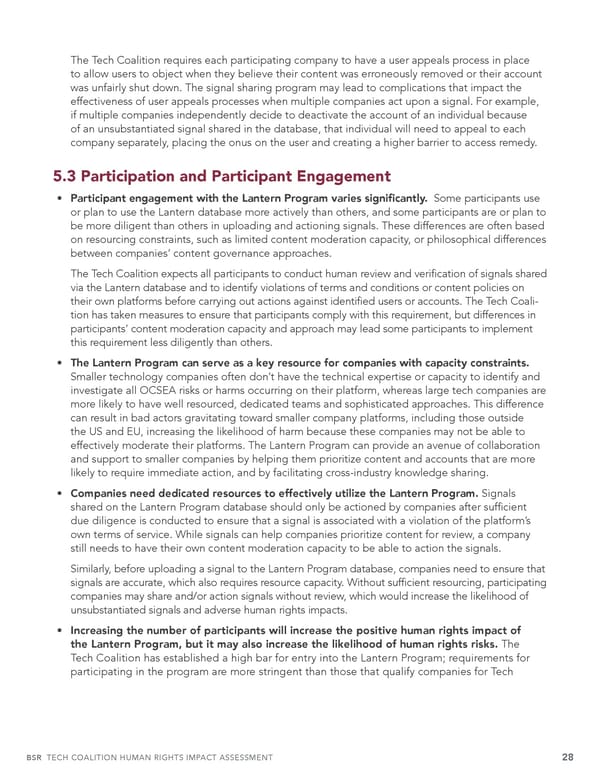The Tech Coalition requires each participating company to have a user appeals process in place to allow users to object when they believe their content was erroneously removed or their account was unfairly shut down. The signal sharing program may lead to complications that impact the effectiveness of user appeals processes when multiple companies act upon a signal. For example, if multiple companies independently decide to deactivate the account of an individual because of an unsubstantiated signal shared in the database, that individual will need to appeal to each company separately, placing the onus on the user and creating a higher barrier to access remedy. 5.3 Participation and Participant Engagement • Participant engagement with the Lantern Program varies signi昀椀cantly. Some participants use or plan to use the Lantern database more actively than others, and some participants are or plan to be more diligent than others in uploading and actioning signals. These differences are often based on resourcing constraints, such as limited content moderation capacity, or philosophical differences between companies’ content governance approaches. The Tech Coalition expects all participants to conduct human review and veri昀椀cation of signals shared via the Lantern database and to identify violations of terms and conditions or content policies on their own platforms before carrying out actions against identi昀椀ed users or accounts. The Tech Coali- tion has taken measures to ensure that participants comply with this requirement, but differences in participants’ content moderation capacity and approach may lead some participants to implement this requirement less diligently than others. • The Lantern Program can serve as a key resource for companies with capacity constraints. Smaller technology companies often don’t have the technical expertise or capacity to identify and investigate all OCSEA risks or harms occurring on their platform, whereas large tech companies are more likely to have well resourced, dedicated teams and sophisticated approaches. This difference can result in bad actors gravitating toward smaller company platforms, including those outside the US and EU, increasing the likelihood of harm because these companies may not be able to effectively moderate their platforms. The Lantern Program can provide an avenue of collaboration and support to smaller companies by helping them prioritize content and accounts that are more likely to require immediate action, and by facilitating cross-industry knowledge sharing. • Companies need dedicated resources to effectively utilize the Lantern Program. Signals shared on the Lantern Program database should only be actioned by companies after suf昀椀cient due diligence is conducted to ensure that a signal is associated with a violation of the platform’s own terms of service. While signals can help companies prioritize content for review, a company still needs to have their own content moderation capacity to be able to action the signals. Similarly, before uploading a signal to the Lantern Program database, companies need to ensure that signals are accurate, which also requires resource capacity. Without suf昀椀cient resourcing, participating companies may share and/or action signals without review, which would increase the likelihood of unsubstantiated signals and adverse human rights impacts. • Increasing the number of participants will increase the positive human rights impact of the Lantern Program, but it may also increase the likelihood of human rights risks. The Tech Coalition has established a high bar for entry into the Lantern Program; requirements for participating in the program are more stringent than those that qualify companies for Tech BSR TECH COALITION HUMAN RIGHTS IMPACT ASSESSMENT 28
 Tech Coalition Human Rights Impact Assessment of the Lantern Program Page 27 Page 29
Tech Coalition Human Rights Impact Assessment of the Lantern Program Page 27 Page 29